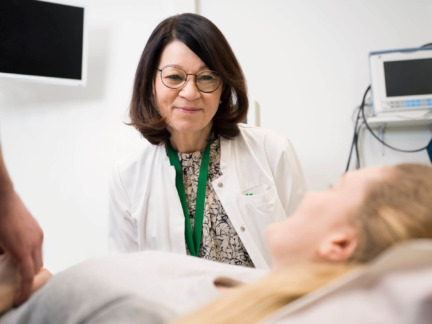In vitro fertilisation (IVF)
In vitro fertilisation (IVF) is used when the likelihood of conception and pregnancy by other means is very low.
In vitro fertilisation treatment is the most effective treatment for infertility. In vitro fertilisation treatment can be used in the case of almost all infertility problems.
Information on starting infertility treatments
What happens in in vitro fertilisation?
In vitro fertilisation treatment aims to grow several follicles in the ovaries at the same time. The growth of ovarian follicles is promoted by subcutaneous follicle-stimulating hormone (FSH) injections. The eggs are collected in an ultrasound-assisted egg retrieval procedure. The eggs are then fertilised with washed sperm in the laboratory. Fertilised eggs and embryos developed from them are cultivated in the laboratory in cell culture cabinets under strictly controlled conditions.
Fertilised embryo is transferred to the uterus
The embryo is transferred to the uterus 2–6 days after fertilisation. One or at most two of the embryos obtained with the best stage of development are selected for transfer to the uterus. The remaining high-quality embryos can be cryopreserved for later use. The implantation of the embryo in the uterus is supported by progesterone medication.
Approximately one in three embryo transfers leads to the birth of a child. In 50% of cases, only one egg retrieval is needed to have a child if the woman is under 35 years of age.
The standard procedure today is to transfer only one embryo to the uterus at a time. Single embryo transfers have not made the outcomes of treatment worse, but the number of twin pregnancies has decreased significantly.
Additional embryos can be cryopreserved
Embryo cryopreservation and thawing procedures are part of IVF treatment. Embryo cryopreservation enables the storage of embryos obtained in the egg retrieval procedure and their possible subsequent transfer into the uterus. The development of high-quality cryopreservation methods has been a prerequisite for adapting the single embryo transfer protocol.
On average, 95% of embryos survive the cryopreservation and thawing process in a new type of fast embryo cryopreservation method, i.e. vitrification.
More information about embryo cryopreservation
Cryopreserved embryo transfer
A cryopreserved embryo transfer can be carried out either in the woman’s natural menstrual cycle or with the help of replacement hormone therapy.
Treatment in a natural cycle is usually carried out if the menstrual cycle is regular (26–32 days). In an ultrasound examination appointment, instructions for performing an ovulation test at home are provided. The embryo transfer date is agreed on the basis of the embryo’s age and ovulation test.
The cryopreserved embryo transfer is carried out with the help of hormone therapy if the menstrual cycle is irregular or at the doctor’s discretion. The inner mucosa of the uterus is grown to a suitable thickness with the help of oestrogen medication. Progesterone is used to prepare the mucosa for embryo implantation. The oestrogen dose is determined on a case by case basis at a doctor’s appointment. The embryo transfer time is agreed on the basis of ultrasound examinations and the embryo’s age.
Approximately one in three cryopreserved embryo transfers leads to a clinical pregnancy. The probability of a pregnancy leading to childbirth is 20–25% per embryo transfer.
Chromosomal abnormalities in the embryo
Aneuploidy refers to an abnormal number of chromosomes in cells. An extra chromosome is called triploidy and a single chromosome deficiency is called monosomy. Normally, there are 46 chromosomes in the embryo’s cells, half of which come from the mother and half from the father. In some cases, as a result of the development of an egg, sperm or early-stage embryo, embryos with aneuploid cells are formed.
Embryos with a normal number of chromosomes have a higher chance of implanting into the uterus and a pregnancy that begins with an embryo with a normal number of chromosomes is more likely to lead to the birth of a healthy child. In some cases, aneuploid embryos can implant into the uterus but cause miscarriage. The embryo may develop, implant itself into the uterus and lead to the birth of a child with a syndrome due to an abnormal number of chromosomes, such as Down’s syndrome.
Aneuploid embryos can occur in any pregnancy. However, their likelihood increases with a woman’s age. Up to 50% of embryos of young women have been found to be aneuploid, while the likelihood of aneuploidy in embryos of women over 42 may be up to more than 80%.
Embryo aneuploidy may be investigated in a PGS study performed in connection with IVF treatment.
Nurse’s support during IVF treatment
In this video, Felicitas Mehiläinen’s midwife and IVF nurse Jenni Kaivola explains what type of treatment is provided to customers and how the treatment proceeds at Felicitas Mehiläinen.
Seeking IVF treatment
Infertility examinations can be easily accessed by booking an appointment in our online service or calling our customer service. A referral is not needed. If you wish, you can ask to see a specific doctor. The examinations begin with a first appointment with an infertility specialist.



